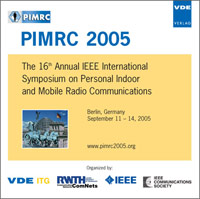Field Experiment Results of User Throughput Performance in WCDMA HSDPA
Konferenz: PIMRC 2005 - 16th Annual IEEE International Symposium on Personal Indoor and Mobile Radio Communications
11.09.2005 - 14.09.2005 in Berlin, Germany
Tagungsband: PIMRC 2005
Seiten: 6Sprache: EnglischTyp: PDF
Persönliche VDE-Mitglieder erhalten auf diesen Artikel 10% Rabatt
Autoren:
Iizuka, Yousuke; Nakamori, Takeshi; Ishii, Hiroyuki; Tanaka, Shinya; Ogawa, Shinsuke; Ohno, Koji (NTT DoCoMo, Inc., 3-5 Hikari-no-oka, Yokosuka-shi, Kanagawa, 239-8536 Japan)
Inhalt:
High-speed downlink packet access (HSDPA) is specified in the 3rd generation partnership project (3GPP) to cope with the increasing demand for high-speed Internet-based multimedia services. This paper presents field experimental results of the user throughput performance in HSDPA to clarify the effects of the maximum number of multi-codes, transmit diversity, and advanced user equipment (UE) such as receive diversity and a chip equalizer. The field experimental results show that 15-multi-code UE, transmit diversity, and receive diversity achieve the peak throughput of 6.5, 8.5, and 10.2 Mbps, respectively, at the average moving speed of 30 km/h in an actual multi-path fading propagation channel, and the average received signal-to-interference power ratio (SIR) is 24 dB. Furthermore, the results show that transmit diversity, receive diversity, and the chip equalizer can improve the average throughput to 27.0%, 54.6%, and 12.8%, respectively, compared to the conventional single antenna Rake receiver when the average received SIR is 16.3 dB.


